
NGC 2264 is the designation number of the New General Catalogue that identifies two astronomical objects as a single object: the Cone Nebula, and the Christmas Tree Cluster. Two other objects are within this designation but not officially included, the Snowflake Cluster, and the Fox Fur Nebula. All of the objects are located in the Monoceros constellation and are located about 720 parsecs or 2,300 light-years from Earth. Due to its relative proximity and large size, it is extremely well-studied. NGC 2264 is sometimes referred to as the Christmas Tree Cluster and the Cone Nebula. However, the designation of NGC 2264 in the New General Catalogue refers to both objects and not the cluster alone. In December 2023, NASA released Christmas holiday-related images by the James Webb Space Telescope, including the Christmas Tree Galaxy Cluster and others.

The Trifid Nebula is an H II region in the north-west of Sagittarius in a star-forming region in the Milky Way's Scutum–Centaurus Arm. It was discovered by Charles Messier on June 5, 1764. Its name means 'three-lobe'. The object is an unusual combination of an open cluster of stars, an emission nebula, a reflection nebula, and a dark nebula. Viewed through a small telescope, the Trifid Nebula is a bright and peculiar object, and is thus a perennial favorite of amateur astronomers.

The Spitzer Space Telescope, formerly the Space Infrared Telescope Facility (SIRTF), was an infrared space telescope launched in 2003, that was deactivated when operations ended on 30 January 2020. Spitzer was the third space telescope dedicated to infrared astronomy, following IRAS (1983) and ISO (1995–1998). It was the first spacecraft to use an Earth-trailing orbit, later used by the Kepler planet-finder.

The Eagle Nebula is a young open cluster of stars in the constellation Serpens, discovered by Jean-Philippe de Cheseaux in 1745–46. Both the "Eagle" and the "Star Queen" refer to visual impressions of the dark silhouette near the center of the nebula, an area made famous as the "Pillars of Creation" imaged by the Hubble Space Telescope. The nebula contains several active star-forming gas and dust regions, including the aforementioned Pillars of Creation. The Eagle Nebula lies in the Sagittarius Arm of the Milky Way.
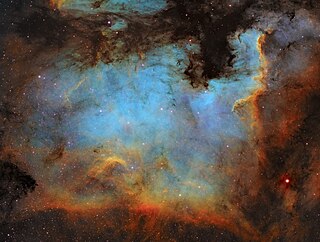
The North America Nebula is an emission nebula in the constellation Cygnus, close to Deneb. It is named because its shape resembles North America.

Centaurus A is a galaxy in the constellation of Centaurus. It was discovered in 1826 by Scottish astronomer James Dunlop from his home in Parramatta, in New South Wales, Australia. There is considerable debate in the literature regarding the galaxy's fundamental properties such as its Hubble type and distance. It is the closest radio galaxy to Earth, as well as the closest BL Lac object, so its active galactic nucleus has been extensively studied by professional astronomers. The galaxy is also the fifth-brightest in the sky, making it an ideal amateur astronomy target. It is only visible from the southern hemisphere and low northern latitudes.
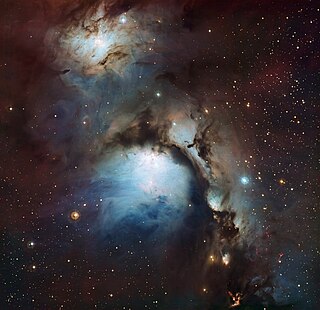
Messier 78 or M78, also known as NGC 2068, is a reflection nebula in the constellation Orion. It was discovered by Pierre Méchain in 1780 and included by Charles Messier in his catalog of comet-like objects that same year.

NGC 7129 is a reflection nebula located 3,300 light years away in the constellation Cepheus. A young open cluster is responsible for illuminating the surrounding nebula. A recent survey indicates the cluster contains more than 130 stars less than 1 million years old. NGC 7129 is located just half a degree from nearby cluster NGC 7142.
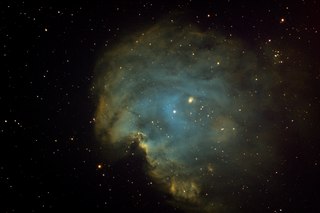
NGC 2174 is an H II emission nebula located in the constellation Orion and is associated with the open star cluster NGC 2175. It was discovered on 6 February 1877 by French astronomer Édouard Stephan. It is thought to be located about 6,400 light-years away from Earth. The nebula may have formed through hierarchical collapse.
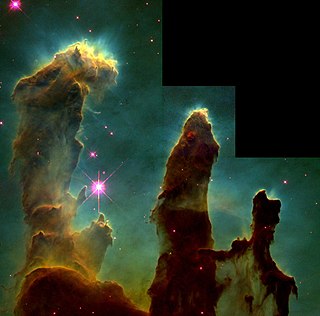
Pillars of Creation is a photograph taken by the Hubble Space Telescope of elephant trunks of interstellar gas and dust in the Eagle Nebula, in the Serpens constellation, some 6,500–7,000 light-years from Earth. These elephant trunks had been discovered by John Charles Duncan in 1920 on a plate made with the Mount Wilson Observatory 60-inch telescope. They are so named because the gas and dust are in the process of creating new stars, while also being eroded by the light from nearby stars that have recently formed.

NGC 6357 is a diffuse nebula near NGC 6334 in the constellation Scorpius. The nebula contains many proto-stars shielded by dark discs of gas, and young stars wrapped in expanding "cocoons" or expanding gases surrounding these small stars. It is also known as the Lobster Nebula. This nebula was given the name War and Peace Nebula by the Midcourse Space Experiment scientists because of its appearance, which, in infrared images the bright, western part resembles a dove, while the eastern part looks like a skull. A petition by anime fans to rename it as the Madokami nebula, due to resemblance with a character, was unsuccessful.

NGC 1333 is a reflection nebula located in the northern constellation Perseus, positioned next to the southern constellation border with Taurus and Aries. It was first discovered by German astronomer Eduard Schönfeld in 1855. The nebula is visible as a hazy patch in a small telescope, while a larger aperture will show a pair of dark nebulae designated Barnard 1 and Barnard 2. It is associated with a dark cloud L1450. Estimates of the distance to this nebula range from 980–1,140 ly (300–350 pc).
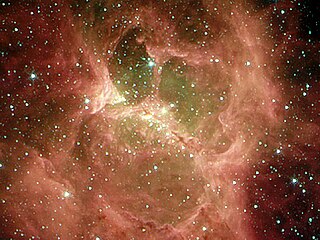
DR 6 is a cluster of stars in the Milky Way galaxy, composed of dust, gas, and about 10 large newborn stars, each roughly ten to twenty times the size of the Sun. It was discovered by astronomers at NASA with the Spitzer Space Telescope, viewing the nebula using infrared light.

The Rho Ophiuchi cloud complex is a complex of interstellar clouds with different nebulae, particularly a dark nebula which is centered 1° south of the star ρ Ophiuchi, which it among others extends to, of the constellation Ophiuchus. At an estimated distance of about 140 parsecs, or 460 light years, it is one of the closest star-forming regions to the Solar System.

RCW 49, also known as NGC 3247, is a H II region nebula located 13,700 light years away. Other designations for the RCW 49 region include NGC 3247 and G29 and it is commonly known as the Whirling Dervish Nebula. It is a dusty stellar nursery that contains more than 2,200 stars and is about 300-400 light years across. RCW 49 is recognized as among the brightest and most massive HII regions.
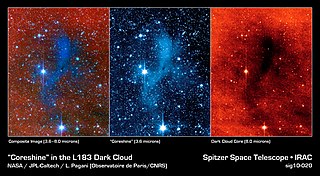
Coreshine is an astronomical term for infrared light scattered by unusually large grains of dust in the denser core regions of molecular clouds and which evidently begin their growth before the start of cloud collapse. These clouds which are opaque to visible light, are a mixture of gas and dust and are the regions where stars are formed.

DR 21 is a large molecular cloud located in the constellation Cygnus, discovered in 1966 as a radio continuum source by Downes and Rinehart. DR 21 is located about 6,000 light-years (1,800 pc) from Earth and extends for 80 light-years (25 pc). The region contains a high rate of star formation and is associated with the Cygnus X star forming region. It has an estimated mass of 1,000,000 M☉.
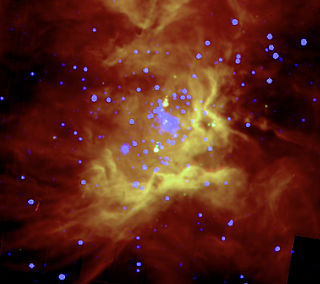
RCW 36 is an emission nebula containing an open cluster in the constellation Vela. This H II region is part of a larger-scale star-forming complex known as the Vela Molecular Ridge (VMR), a collection of molecular clouds in the Milky Way that contain multiple sites of ongoing star-formation activity. The VMR is made up of several distinct clouds, and RCW 36 is embedded in the VMR Cloud C.
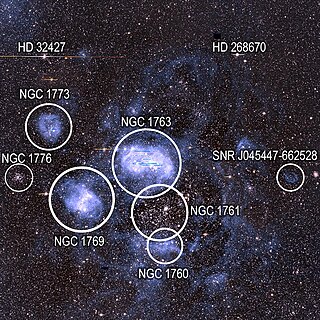
N11 is the brightest emission nebula in the north-west part of the Large Magellanic Cloud in the Dorado constellation. The N11 complex is the second largest H II region of that galaxy, the largest being the Tarantula Nebula. It covers an area approximately 6 arc minutes across. It has an elliptical shape and consists of a large bubble, generally clear interstellar area, surrounded by nine large nebulae. It was named by Karl Henize in 1956.
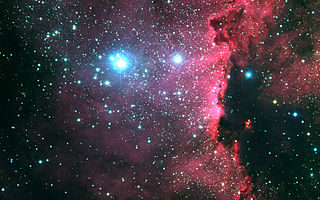
RCW 108, also called the Rim Nebula, is a large star formation in the Milky Way, about 4,000 light years from Earth. RCW 108 is part of the Constellation Ara. is in the process of being destroyed by intense light which radiates from a star inside of NGC 6193. NGC 6188 has an angular extent of 20.0' × 12.0', and has been heavily documented by multiple telescopes, including Chandra and Spitzer.




















